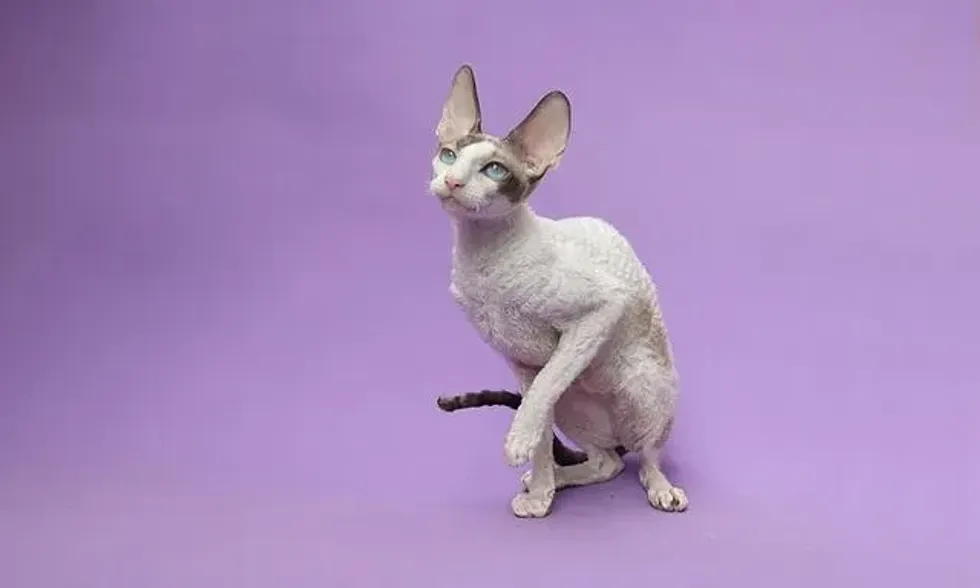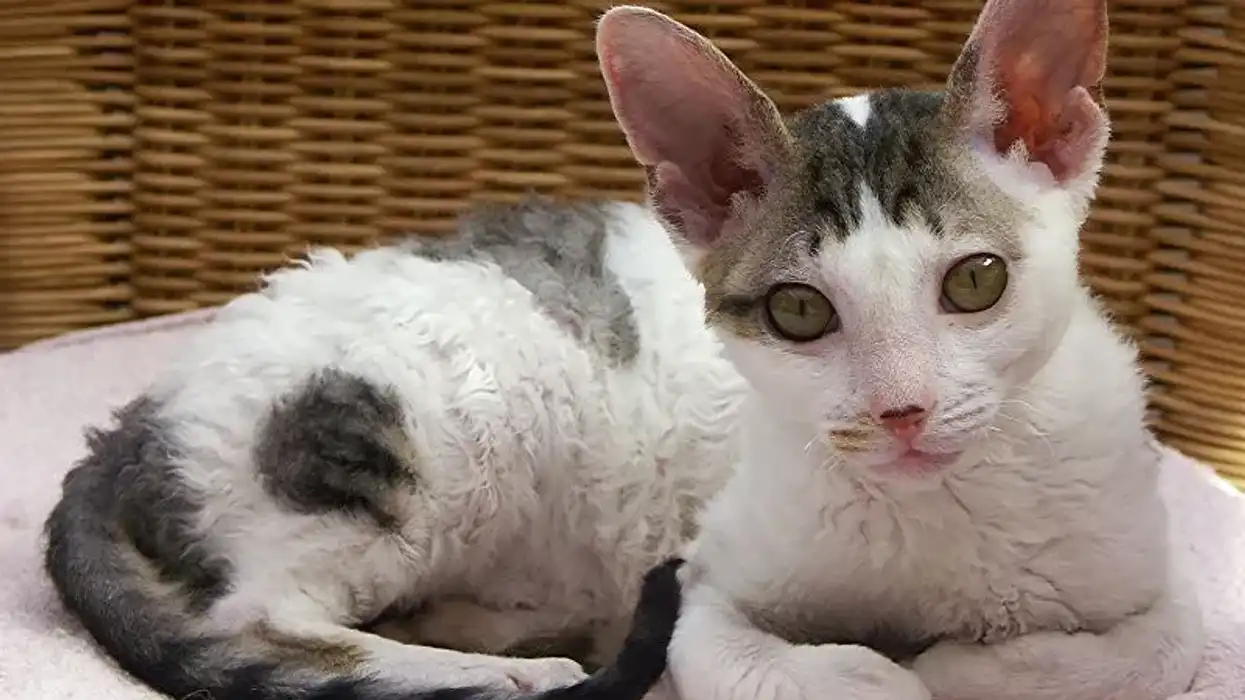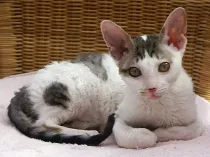Fun Cornish Rex Facts For Kids

Content
- What type of animal is a Cornish Rex?
- What class of animal does a Cornish Rex belong to?
- How many Cornish Rexes are there in the world?
- Where does a Cornish Rex live?
- What is a Cornish Rex's habitat?
- Who do Cornish Rex live with?
- How long does a Cornish Rex live?
- How do they reproduce?
- What is their conservation status?
- What do Cornish Rex look like?
- How cute are they?
- How do they communicate?
- How big is a Cornish Rex?
- How fast can a Cornish Rex run?
- How much does a Cornish Rex weigh?
- What are their male and female names of the species?
- What would you call a baby Cornish Rex?
- What do they eat?
- Are they slobbery?
- Would they make a good pet?
- Did you know...
- Can Cornish Rex cats be left alone?
- Getting your own Cornish Rex
Are you a cat lover and want to know about an interesting cat breed? The Cornish Rex is a unique cat breed that likes to play fetch with its owner.
A Cornish Rex cat is blessed with curly-coated fur and an arched back that distinguishes them from other breeds of cats. It has sharp, prominent ears that add to its elegant appearance.
Other distinct characteristics include the different colors and patterns of the fur in their body. These breeds with curly fur, care a great deal about their owners and love to play fetch. The Cornish Rex breed cats make great pets.
They need proper grooming as otherwise, they can suffer from health problems. A Cornish Rex cat breed has an average litter size of four to six and curly-coated kittens are born after a gestation period of 71 days.
The first Cornish Rex kitten was born through natural mutation in 1950 on a farm in Cornwall, England. If you want to know more about these fur babies and their characteristics, then keep on reading.
If you want to know more about another interesting cat breed, then check out Balinese cat and leopard cat facts too.
Cornish Rex Interesting Facts
What type of animal is a Cornish Rex?
The Cornish Rex is a type of domestic cat breed that belongs to the family of Felidae.
What class of animal does a Cornish Rex belong to?
The Cornish Rex belongs to the Mammalia class and the genus Felis.
How many Cornish Rexes are there in the world?
As Cornish Rexes live with their owners all over the world, the exact number of this breed present globally is not known.
Where does a Cornish Rex live?
A Cornish Rex is a domestic cat that lives with its breeders or owners in their houses all over the world. It is a kind of pet breed that needs proper grooming and can face health issues otherwise.
What is a Cornish Rex's habitat?
The Cornish Rex cat breed generally tends to be sensitive to low temperatures. They prefer living indoors in warm and dry conditions. A Cornish Rex breed is often found near warm places inside the house like computer monitors, bulbs, shoulders, and laps of their favorite humans.
Who do Cornish Rex live with?
Cornish Rex cats, being domestic cats, live with their owners. They are the perfect companion for cat lovers who are active and like having fun. Cornish Rex cats can make a game out of everything and expect their favorite human to join in. Their sociable mood is very hard to ignore and spending time with them works like therapy.
How long does a Cornish Rex live?
Cornish Rex cats are known for having a long lifespan. It can live a healthy, and active life for up to 15 years. It is also not surprising for a Cornish Rex to live up to 20 years. It generally tends to take its energetic and playful nature into old age.
How do they reproduce?
A Cornish Rex's reproduction is not different from any other cat's. These pet cat breeds have multiple estrous cycles throughout the year and the mating season generally depends on the temperature and location.
It is important to check the blood type of the Rexes before breeding as it might affect the Cornish Rex kittens. A Cornish Rex will not be born if two non-Cornish variants are crossed. After successful fertilization and a gestation period of about 71 days, four to six kittens are born with a curly coat of fur.
The kittens of this breed need proper care and attention to avoid health problems. These breeds of kittens can grow up to make a great pet and companion.
What is their conservation status?
Even though the first Cornish Rex kitten was born through natural mutation in 1950 on a farm in Cornwall, England, Cornish Rex cats breed in captivity and live all over the world in households. It is quite difficult to keep track of their population.
However, it is safe to assume that their population is not at any immediate risk, as their conservation status is Not Listed under the International Union for Conservation of Nature or IUCN Red List.
Cornish Rex Fun Facts
What do Cornish Rex look like?
A Cornish Rex is a cat that is found in all kinds of patterns and colors. The color ranges from white, black, red, blue, brown to frost, cream, platinum, cinnamon, lavender, and so on.
Its fascinating curly-coated fur makes it unique among cats. The coat is soft, silky, and curly which forms waves to take a shape of corn-rows.
Now, coming to the physical appearance, the Cornish Rex is small to a medium-sized cat with a naturally arched back. The Cornish Rex has an egg-shaped head which is comparatively smaller than the other features. Cornish Rex's ears are erected, large and prominent and the eyes are oval-shaped and slightly upward slanting.
It is blessed with prominent cheekbones that are well-chiseled. Cornish Rex stands on its legs which are quite long and slender.
It has oval delicate paws with four toes in the back and five in the front. Cornish Rex has a long, slender tail that is quite flexible especially towards the end.

How cute are they?
The Cornish Rex is a fascinating animal and makes great pets. It has unique features like an egg-shaped head, curly coat, and all kinds of colors and patterns. And to further add to its beauty, it is blessed with large ears and a flexible tail.
All these put together makes a Cornish Rex extremely cute. It also has a very playful attitude that makes people want to pet it. So, both its physical appearance and behavioral characteristics make Cornish Rex one of the cutest cats.
How do they communicate?
Like all other cats in the world, a Cornish Rex communicates with humans and other cats through vocalization, visual cues, and physical contact. Vocal communication within cats using meowing, hissing, and purring is extremely common.
They meow, hiss, or purr to get what they want or to convey their messages. Cats are also known for using physical contact to communicate.
They have different body posture and facial expressions that they use to show their mood or discomfort. Cats also have a strong sense of scent that they put to good use.
How big is a Cornish Rex?
A Cornish Rex generally is a small to medium-sized breed of cat. It generally tends to stand on its legs and thus might appear larger than other cats. They have a height of 8-12 in (20.3-30.5cm) that is almost as big as a normal cat. Its body forms an upward curve by following the upward curve of the backbone.
How fast can a Cornish Rex run?
The Cornish Rex, being a domestic cat, would enjoy playing a game of fetch with its owner if trained in the right way. It needs constant exercise to keep its weight in check and is often found running in the house or the garden of its owner.
It is quite quick on its feet just like other cats. However, the exact speed of Cornish Rex is not known.
How much does a Cornish Rex weigh?
An average male Cornish Rex weighs somewhere between 6-9 lb (2.7-4.1 kg) and an average female Cornish Rex weighs no more than 5-7 lb (2.3-3.2 kg).
What are their male and female names of the species?
The Cornish Rex has no specific name for their male and female species. However, a male cat is referred to as a Tomcat, and a female cat is referred to as a Molly.
What would you call a baby Cornish Rex?
Just like all other cats, a baby Cornish Rex is known as a kitten.
What do they eat?
The Cornish Rex is a quite greedy cat when it comes to food and they love to eat. It is extremely important to not get fooled by their demands and maintain a healthy diet that is approved by the veterinarian.
It needs a high-quality cat food diet like other cats.
Being an active cat, the Cornish Rex always has an appetite and needs their food bowl replenished all the time.
If a good eating routine is not established by the owner, the cat may face a couple of health issues like obesity and their coat shape will get messed up. A routine diet of cat food with occasional fruits and vegetables is all a Cornish Rex needs to live a healthy life.
Are they slobbery?
Unlike dogs, cats do not drool often as it is not a normal physiological response for them. At times, they might drool when extremely excited or hungry but they do not drool continuously or excessively.
This is the case with a Cornish Rex cat or kitten as well. However, cats are very likely to develop or catch oral and dental diseases that can cause excessive salivation.
Cats need immediate attention when something like this happens and a veterinarian should be contacted immediately. Health issues like lesions, gum disease, infections, and mouth ulcers are some common reasons that make cats drool.
Would they make a good pet?
Unlike most cats, the Cornish Rex is known for its social nature. It gets along with everybody including children and other pets.
It is an adaptable breed of cat and can adjust to almost all kinds of environments. The Cornish Rex is an intelligent breed who can be taught various tricks like waving, shaking, and sitting on command.
It can be even trained to play a game of fetch where they use their paws to pick the items up. It loves getting appreciated when a job is well done.
A Cornish Rex cat needs nothing more than a proper diet with timely food and quality time with family members. So a Cornish Rex is an amazing companion and a great pet.
Adding them to the family might be one of the greatest decisions. Also, they are often taken up as therapy cats due to their social, friendly nature and intelligence.
Did you know...
Like most cats, the Cornish Rex is non-hypoallergenic. Although, some people have the misconception that Cornish Rex's short hair helps them to be hypoallergenic. The length of hair has nothing to do with allergic reactions.
The sebaceous glands of saliva, skin, and urine produce a glycoprotein called Fel d 1. This protein present in cat saliva and skin affects people with cat allergies. The Cornish Rex produces this despite being a groomed breed of cat and causes an allergic reaction to visitors with a low tolerance level.
A curly coat is one of the most distinguishing features of the Cornish Rex. Most cats are self-groomers but Cornish Rex cats need some extra care for their most obvious feature, the curly coat.
The Cornish Rex does not shed much but the Cornish Rex is a cat breed that lacks guard hairs and awn hairs. That is why the coat, comprising of only down hairs, can get oily at times, especially the paws and chin region.
Unlike other cats, a Cornish Rex needs a bath on a regular basis to avoid greasiness. A good gentle brush following the bath can keep their tight curls in check and help avoid their becoming greasy.
Can Cornish Rex cats be left alone?
A domestic cat requires a lot of care. It needs timely food and daily attention.
Being social cats, the Cornish Rex needs plenty of owner interaction, in fact, more than other breeds of cat. It needs to spend a great deal of time with its parent every day for mental stimulation.
As the Cornish Rex is an intelligent breed, mental stimulation is extremely important. The Cornish Rex is a type of cat that wants to be with its parents and goes to huge extents to spend more time with them.
It loves getting maintained and handled by its owner or parents. It is not a wise idea to leave a Cornish Rex alone for a long time as it might face separation anxiety and get depressed.
Getting your own Cornish Rex
The Cornish Rex is a fascinating cat breed that is intelligent, loyal, friendly, and affectionate. So basically, it ticks all the boxes for making a good pet.
It will bring in a perfect combination of elegance and amusement. So adopting a Cornish Rex is a great idea. However, it is important to adopt them from a proper breeder.
In America, a Cornish Rex kitten is sold at a price of $800-$1200. There are certain points that should be kept in mind before bringing this bundle of joy to the family.
The Cornish Rex is a very active cat and needs one-on-one time with its parent to exercise properly. Lack of proper exercise and proper diet can make a Cornish Rex suffer from a couple of health issues.
The Cornish Rex is an extremely social animal and needs constant attention and cannot be left alone for a long period of time.
Although they are quite low maintenance, they require daily attention and care. So, if you can give adequate time and attention, then you should definitely get a Cornish Rex.
Here at Kidadl, we have carefully created lots of interesting family-friendly animal facts for everyone to discover! Learn more about some other mammals including Somali cat, or Siamese cat.
You can even occupy yourself at home by drawing one on our Cornish Rex cat coloring pages.
We Want Your Photos!
More for You
See All
Bachelor of Arts specializing in Journalism and Mass Communication, Postgraduate Diploma in Sports Management

Moumita DuttaBachelor of Arts specializing in Journalism and Mass Communication, Postgraduate Diploma in Sports Management
A content writer and editor with a passion for sports, Moumita has honed her skills in producing compelling match reports and stories about sporting heroes. She holds a degree in Journalism and Mass Communication from the Indian Institute of Social Welfare and Business Management, Calcutta University, alongside a postgraduate diploma in Sports Management.
Bachelor of Law

Abdulqudus MojeedBachelor of Law
A versatile professional with a passion for creative writing and technology. Abdulqudus is currently pursuing his Bachelor of Law from the University of Lagos and has experience as a tutor, intern assistant, and volunteer. He possesses strong organizational skills and is a detail-oriented person.
Disclaimer
1) Kidadl is independent and to make our service free to you the reader we are supported by advertising. We hope you love our recommendations for products and services! What we suggest is selected independently by the Kidadl team. If you purchase using the Buy Now button we may earn a small commission. This does not influence our choices. Prices are correct and items are available at the time the article was published but we cannot guarantee that on the time of reading. Please note that Kidadl is a participant in the Amazon Services LLC Associates Program, an affiliate advertising program designed to provide a means for sites to earn advertising fees by advertising and linking to Amazon. We also link to other websites, but are not responsible for their content.
2) At Kidadl, we strive to recommend the very best activities and events. We will always aim to give you accurate information at the date of publication - however, information does change, so it’s important you do your own research, double-check and make the decision that is right for your family. We recognise that not all activities and ideas are appropriate for all children and families or in all circumstances. Our recommended activities are based on age but these are a guide. We recommend that these ideas are used as inspiration, that ideas are undertaken with appropriate adult supervision, and that each adult uses their own discretion and knowledge of their children to consider the safety and suitability. Kidadl cannot accept liability for the execution of these ideas, and parental supervision is advised at all times, as safety is paramount. Anyone using the information provided by Kidadl does so at their own risk and we can not accept liability if things go wrong.
3) Because we are an educational resource, we have quotes and facts about a range of historical and modern figures. We do not endorse the actions of or rhetoric of all the people included in these collections, but we think they are important for growing minds to learn about under the guidance of parents or guardians.







